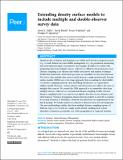Extending density surface models to include multiple and double-observer survey data
Abstract
Spatial models of density and abundance are widely used in both ecological research (e.g., to study habitat use) and wildlife management (e.g., for population monitoring and environmental impact assessment). Increasingly, modellers are tasked with integrating data from multiple sources, collected via different observation processes. Distance sampling is an efficient and widely used survey and analysis technique. Within this framework, observation processes are modelled via detection functions. We seek to take multiple data sources and fit them in a single spatial model. Density surface models (DSMs) are a two-stage approach: first accounting for detectability via distance sampling methods, then modelling distribution via a generalized additive model. However, current software and theory does not address the issue of multiple data sources. We extend the DSM approach to accommodate data from multiple surveys, collected via conventional distance sampling, double-observer distance sampling (used to account for incomplete detection at zero distance) and strip transects. Variance propagation ensures that uncertainty is correctly accounted for in final estimates of abundance. Methods described here are implemented in the dsm R package. We briefly analyse two datasets to illustrate these new developments. Our new methodology enables data from multiple distance sampling surveys of different types to be treated in a single spatial model, enabling more robust abundance estimation, potentially over wider geographical or temporal domains.
Citation
Miller , D L , Fifield , D , Wakefield , E & Sigourney , D B 2021 , ' Extending density surface models to include multiple and double-observer survey data ' , PeerJ , vol. 9 , e12113 . https://doi.org/10.7717/peerj.12113
Publication
PeerJ
Status
Peer reviewed
ISSN
2167-8359Type
Journal article
Description
David L. Miller was funded by OPNAV N45 and the SURTASS LFA Settlement Agreement, being managed by the U.S. Navy’s Living Marine Resources program under Contract No. N39430-17-C-1982, collaboration between Douglas B. Sigourney and David L. Miller was also facilitated by the DenMod working group (https://synergy.st-andrews.ac.uk/denmod/) funded under the same agreement. The survey that the fin whale data originate from was funded through two inter-agency agreements with the National Marine Fisheries Service: inter-agency agreement number M14PG00005 with the US Department of the Interior, Bureau of Ocean Energy Management, Environmental Studies Program, Washington, DC and inter-agency agreement number NEC-16-011-01-FY18 with the US Navy. The survey that the fulmar data originate from was funded by the UK Natural Environmental Research Council (NERC) grant NE/M017990/1.Collections
Items in the St Andrews Research Repository are protected by copyright, with all rights reserved, unless otherwise indicated.

